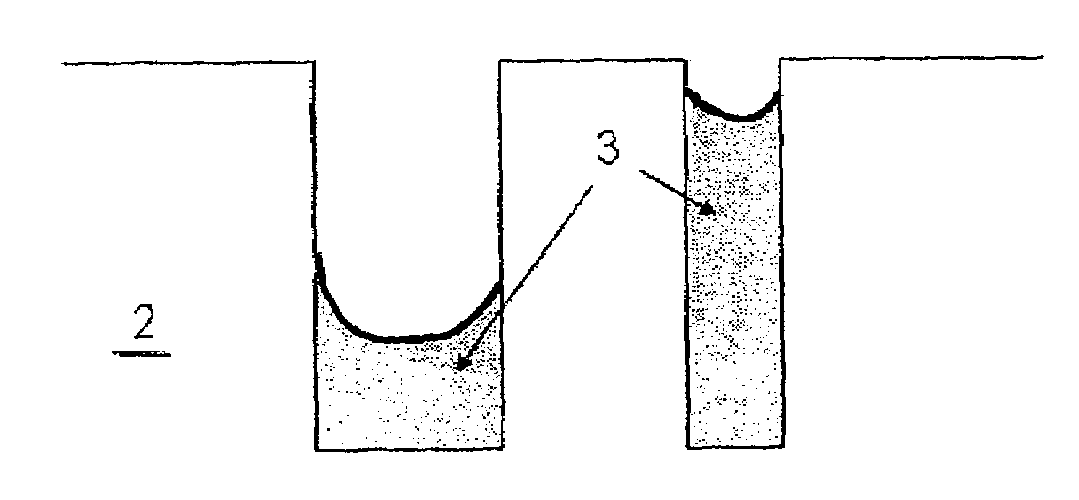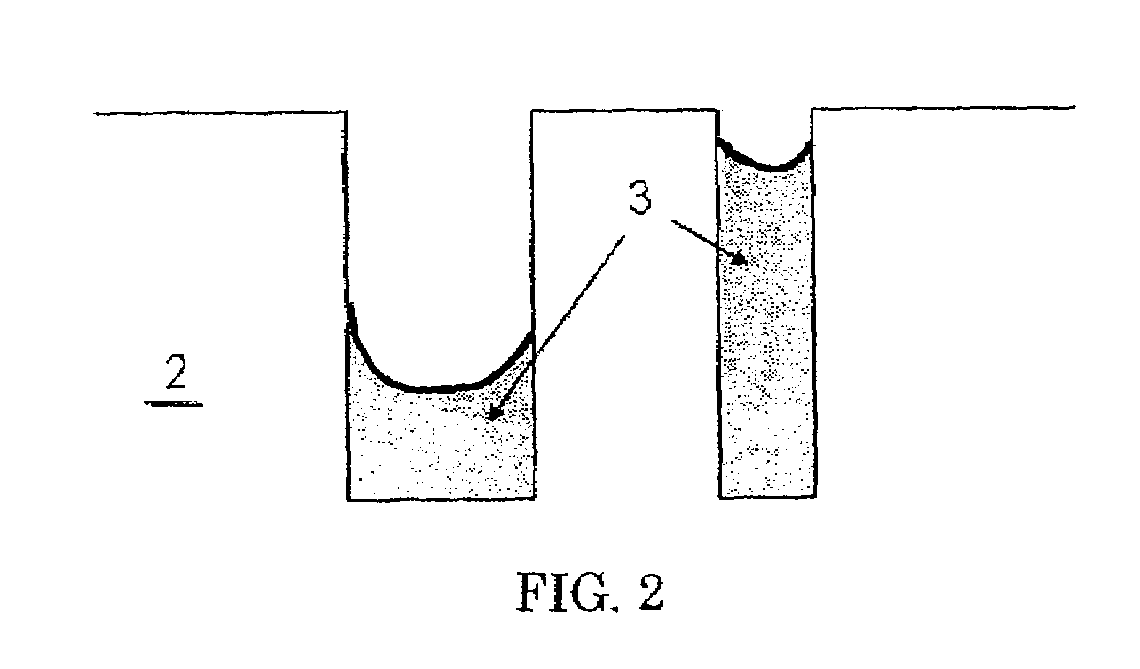Device isolation technology on semiconductor substrate
- Summary
- Abstract
- Description
- Claims
- Application Information
AI Technical Summary
Problems solved by technology
Method used
Image
Examples
example 1
[0052]With reference to the features of FIGS. 1 and 2, an insulative layer 3 was formed by introducing SiH4, n-hexane and nitrogen gas into a reaction chamber for CVD processing wherein a semiconductor substrate 2 having trenches 8 was placed. The trenches included relatively wide trenches (a width of 500 m and a depth of 350 nm) and relatively narrow trenches (a width of 50 nm and a depth of 350 nm). The flow rates of SiH4, n-hexane, and nitrogen gas are shown in Table 1. No oxidizing gas was used. RF power (a frequency of 13.56 MHz, 200 W) was applied to generate plasma over the substrate 2. The SiH4 and solvent reacted in the presence of the inert gas on the surface of the semiconductor substrate 2 having the trenches 8 to form the insulative layer 3. The semiconductor substrate 2 may be maintained at a temperature ranging from approximately 0° C. to 200° C. by placing the semiconductor substrate 2 on a chuck maintained at that temperature. In this example, the semiconductor subs...
example 2
[0056]An insulative layer 3 was formed by introducing SiH4, TMDSZ and NH3 into a reaction chamber for CVD processing wherein a semiconductor substrate 2 having trenches 8 was placed. The trenches included relatively wide trenches (a width of 500 nm and a depth of 350 nm) and relatively narrow trenches (a width of 50 nm and a depth of 350 nm). The flow rates of SiH4, n-hexane, and nitrogen gas are shown in Table 2. No oxidizing gas was used. RF power (a frequency of 13.56 MHz, 200 W) was applied to generate plasma over the substrate 2. The SiH4 and TMDSZ reacted in the presence of the NH3 gas on the surface of the semiconductor substrate 2 having the trenches 8 to form the insulative layer 3. The semiconductor substrate 2 may be maintained at a temperature ranging from approximately 0° C. to 200° C. by placing the semiconductor substrate 2 on a chuck maintained at that temperature. In this example, the semiconductor substrate 2 may be maintained at a temperature of approximately 30° ...
example 3
[0061]To determine the chemical bonding and compositions of multi-step cured insulative layers, the insulative layers 3 were deposited on a blanket wafer by PECVD at 30° C. according to the processes described in Example 1. The multi-step curing was comprised of oxygen-containing treatment (baking), oxygen UV curing, and thermal annealing, which were conducted as follows:
[0062]Baking:
[0063]Oxygen gas: 3 slm
[0064]Nitrogen gas: 1 slm
[0065]Temperature: 400° C.
[0066]Duration: 1 minute
[0067]Pressure: 800 Pa
[0068]UV Curing:
[0069]UV lamp: Xe lamp (100 mW / cm2)
[0070]Oxygen gas: 3 slm
[0071]Nitrogen gas: 1 slm
[0072]Temperature: 430° C.
[0073]Duration: 2 minutes
[0074]Pressure: 1200 Pa
[0075]Thermal Annealing:
[0076]Oxygen gas: 3 slm
[0077]Nitrogen gas: 1 slm
[0078]Temperature: 430° C.
[0079]Duration: 30 minutes
[0080]Pressure: 800 Pa
[0081]FIGS. 3 and 4 are Fourier-transform infrared absorption spectra (FTIR) analysis of insulative layers 3 deposited as described above. FIG. 3 shows the as-deposited re...
PUM
 Login to View More
Login to View More Abstract
Description
Claims
Application Information
 Login to View More
Login to View More - R&D
- Intellectual Property
- Life Sciences
- Materials
- Tech Scout
- Unparalleled Data Quality
- Higher Quality Content
- 60% Fewer Hallucinations
Browse by: Latest US Patents, China's latest patents, Technical Efficacy Thesaurus, Application Domain, Technology Topic, Popular Technical Reports.
© 2025 PatSnap. All rights reserved.Legal|Privacy policy|Modern Slavery Act Transparency Statement|Sitemap|About US| Contact US: help@patsnap.com



